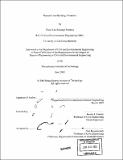| dc.contributor.advisor | Jerome J. Connor. | en_US |
| dc.contributor.author | Floresca, Diane Lee Bosuego, 1979- | en_US |
| dc.contributor.other | Massachusetts Institute of Technology. Dept. of Civil and Environmental Engineering. | en_US |
| dc.date.accessioned | 2006-03-24T16:01:21Z | |
| dc.date.available | 2006-03-24T16:01:21Z | |
| dc.date.copyright | 2003 | en_US |
| dc.date.issued | 2003 | en_US |
| dc.identifier.uri | http://hdl.handle.net/1721.1/29550 | |
| dc.description | Thesis (M.Eng.)--Massachusetts Institute of Technology, Dept. of Civil and Environmental Engineering, 2003. | en_US |
| dc.description | Includes bibliographical references (leaf 63). | en_US |
| dc.description.abstract | Underground and surface arteries for vehicle or railway traffic can create vibrations that travel to nearby buildings. These vibrations can cause structural damage or human discomfort. Displacement time histories collected from buildings abutting the central surface artery were used to drive mathematical models so that asphaltic and polymeric bearings could be studied as possible passive mitigators of such vibrations. Neither material attenuated vibrations to below threshold levels for human annoyance, but they could dampen levels to resist structural damage if enough material was used to bring the apparent natural frequency away from the range characteristic of traffic vibration. In addition, for resonant cases, the materials did not create enough damping force to counter the inertia of heavy structures, because the materials were too stiff and the displacements and velocities too small. For new construction, it is suggested that these vibrations should be prevented from entering the foundation area by surrounding the foundation with a concrete wall or absorbent foam blocks. For retrofits, polymeric or asphaltic pads could be used and would be relatively easy to install. | en_US |
| dc.description.statementofresponsibility | by Diane Lee Bosuego Floresca. | en_US |
| dc.format.extent | 63 leaves | en_US |
| dc.format.extent | 2166087 bytes | |
| dc.format.extent | 2165895 bytes | |
| dc.format.mimetype | application/pdf | |
| dc.format.mimetype | application/pdf | |
| dc.language.iso | eng | en_US |
| dc.publisher | Massachusetts Institute of Technology | en_US |
| dc.rights | M.I.T. theses are protected by copyright. They may be viewed from this source for any purpose, but reproduction or distribution in any format is prohibited without written permission. See provided URL for inquiries about permission. | en_US |
| dc.rights.uri | http://dspace.mit.edu/handle/1721.1/7582 | |
| dc.subject | Civil and Environmental Engineering. | en_US |
| dc.title | Research into building vibrations | en_US |
| dc.type | Thesis | en_US |
| dc.description.degree | M.Eng. | en_US |
| dc.contributor.department | Massachusetts Institute of Technology. Department of Civil and Environmental Engineering | |
| dc.identifier.oclc | 52723200 | en_US |
